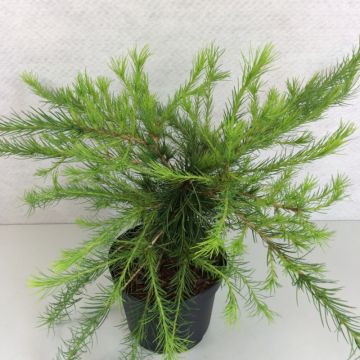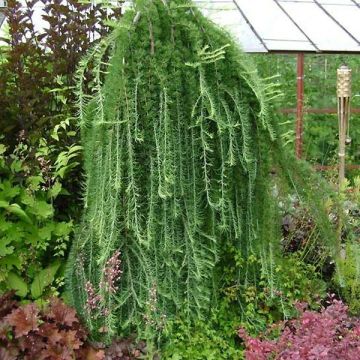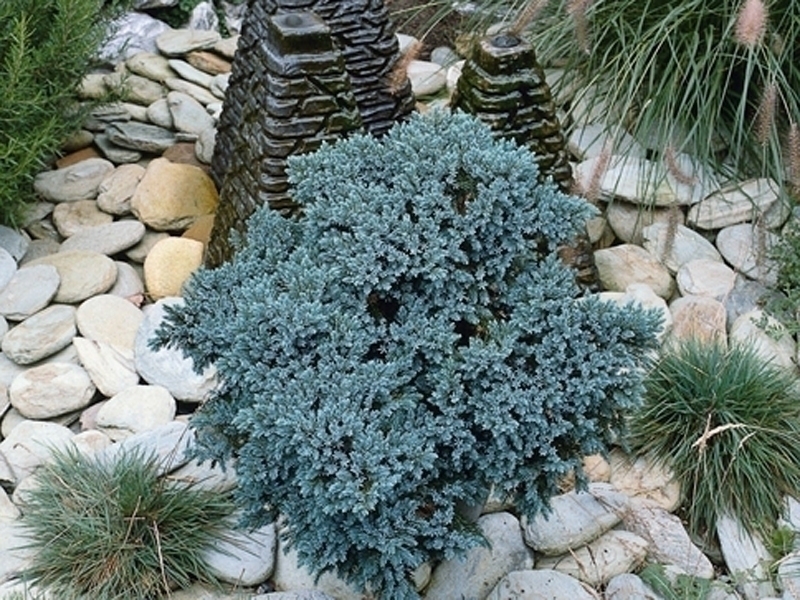

Larix decidua - Mélèze d'Europe
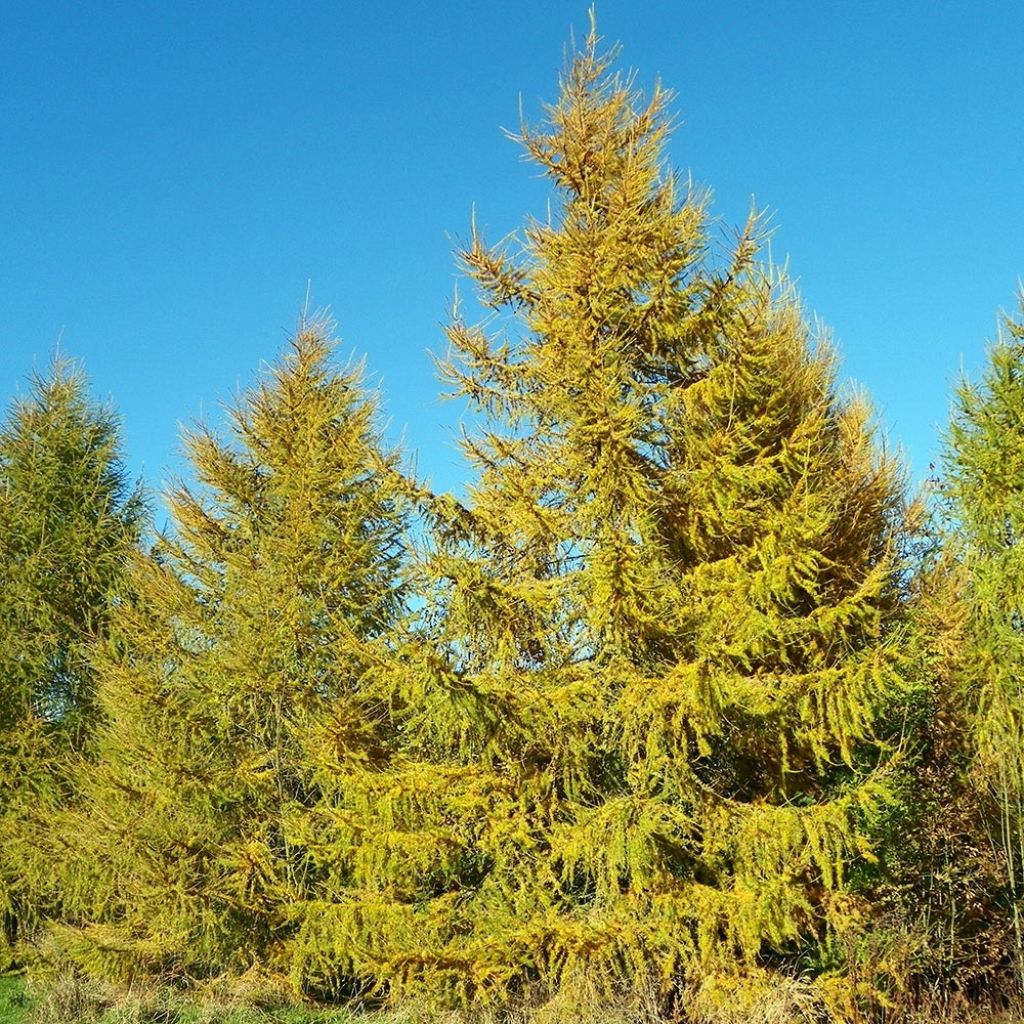

Larix decidua - Mélèze d'Europe


Larix decidua - Mélèze d'Europe


Larix decidua - Mélèze d'Europe
Larix decidua - Larch
Larix decidua
European Larch, Common Larch
Tree received in perfect condition in excellent packaging and more beautiful (and impressive) than the description given on the website.
Jean-Marie, 09/11/2023
Special offer!
Receive a €20 voucher for any order over €90 (excluding delivery costs, credit notes, and plastic-free options)!
1- Add your favorite plants to your cart.
2- Once you have reached €90, confirm your order (you can even choose the delivery date!).
3- As soon as your order is shipped, you will receive an email containing your voucher code, valid for 3 months (90 days).
Your voucher is unique and can only be used once, for any order with a minimum value of €20, excluding delivery costs.
Can be combined with other current offers, non-divisible and non-refundable.
Why not try an alternative variety in stock?
View all →This plant carries a 24 months recovery warranty
More information
We guarantee the quality of our plants for a full growing cycle, and will replace at our expense any plant that fails to recover under normal climatic and planting conditions.

Would this plant suit my garden?
Set up your Plantfit profile →
Description
The Larix decidua, more commonly known as the European larch, is a large iconic conifer of the Alps, and the only deciduous conifer in Europe. This large tree bears rather soft foliage that successively turns from light green in spring to dark bluish-green in summer before becoming golden yellow in autumn. Very hardy, this mountain species adapts well to the plains, provided it is given sunny exposure, well-drained soil, even poor and calcareous, and space.
The European larch, Larix decidua, is a large conifer that can reach 30 m (98 ft 5 in) in height and 15-20m (49 ft 2 in-65 ft 7 in) in width, whose needles fall in autumn. It originates from the mountains of central and southern Europe, at altitudes between 1400 and 2400 m (4593 ft 2 in and 7874 ft). It is a pioneer species capable of improving poor or degraded soils, with great hardiness (up to -40°C), which develops a long tap root allowing it to resist wind perfectly and to seek moisture in depth. It belongs to the Pinaceae family, such as pines, firs, and spruces. It is a species very close to the Japanese Larix kaempferi.
The Larix decidua has a generally rounded pyramidal habit, relatively airy. Its growth is moderately fast. Its trunk is straight, it develops numerous almost horizontal branches, the ends of which are sometimes trailing. The bark is greyish in colour, cracked, and very thick on old specimens. On the trunk, this bark becomes reddish-brown and cracks into large scales with age. In spring, the branches are dressed in soft needle-like foliage, of a brilliant light green. They are inserted in rosettes on the branches, and grouped in tufts composed of 35 to 40 units. They take a darker bluish-green hue in summer before turning golden yellow in autumn. The flowering starts before the appearance of the needles in spring and takes place between March and July. The tree produces male and female cones. It is only when the latter have been pollinated that the foliage appears and the branches lengthen. The male cones are numerous, small and yellowish, and hang under the branches. The female cones, on the other hand, are erect and of a pretty bright pink colour, before turning brown at ripeness. At the end of summer, they release brown seeds that are a delight for squirrels and certain birds.
The common larch is a low-demand conifer, easy to grow in the mountains but also in plain gardens, provided the soil remains somewhat fresh in depth and it is placed in a sunny exposure. It will be placed in isolation or in an airy grove, in a large garden or in a park. It can also be made into a delightful bonsai. The graphic qualities of conifers naturally impose themselves in the design of a contemporary garden, which favours forms, silhouettes and textures over the waltz of foliage and flowering.
Advice : Water regularly during the first two years, and in cases of prolonged drought. While it accepts relatively dry soil in cool or mountainous climates, this conifer will be disappointing in climates that are too dry in summer.
Larix decidua - Larch in pictures


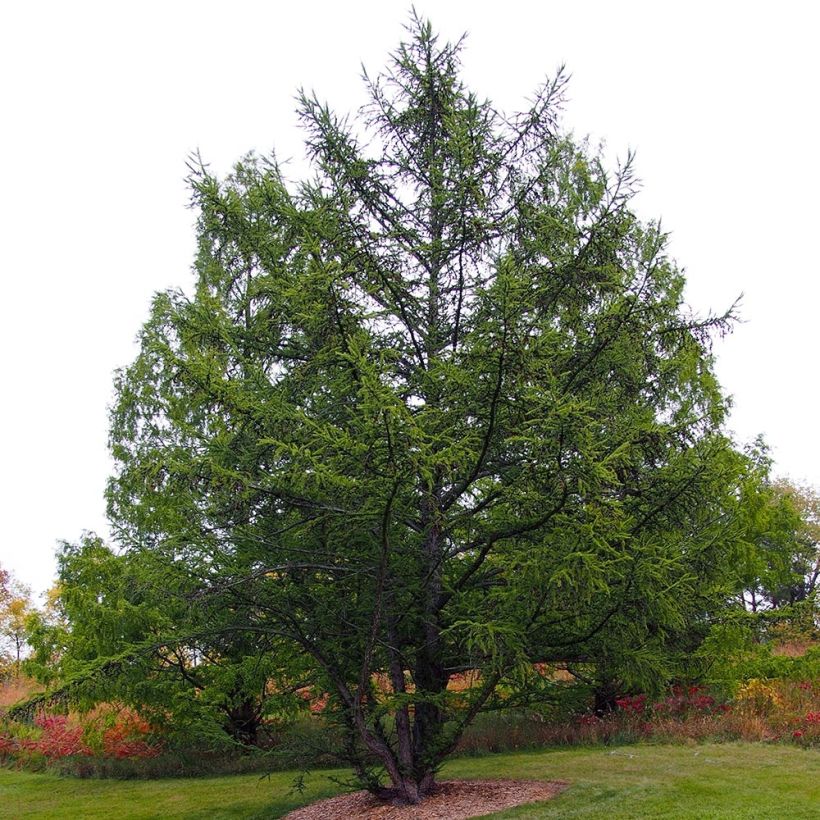



Plant habit
Flowering
Foliage
Botanical data
Larix
decidua
Pinaceae
European Larch, Common Larch
Alps
Other Larix - Larch
View all →Planting and care
The Larix decidua is a very hardy montane climate plant, not demanding, but dreads arid situations. It is planted from September to November (preferably when the foliage has fallen) in well-drained soil but keeping some freshness, even poor and calcareous, in a sunny place. A mixture containing coarse sand and compost added to the garden soil will suit this plant very well. If your soil is too heavy, a little trick is to plant your tree on a mound and mulch it with gravel. Water regularly during the first two years, and in cases of prolonged drought. Soak the root balls well before planting. This very hardy conifer dreads heavy, water-logged soils. Pruning is not necessary, but this conifer can be perfectly pruned to remove dead wood or eliminate annoying branches. Pruning will take place in February-March.
Planting period
Intended location
Care
Planting & care advice
-
, onOrder confirmed
Reply from on Promesse de fleurs
Similar products
Haven't found what you were looking for?
Hardiness is the lowest winter temperature a plant can endure without suffering serious damage or even dying. However, hardiness is affected by location (a sheltered area, such as a patio), protection (winter cover) and soil type (hardiness is improved by well-drained soil).

Photo Sharing Terms & Conditions
In order to encourage gardeners to interact and share their experiences, Promesse de fleurs offers various media enabling content to be uploaded onto its Site - in particular via the ‘Photo sharing’ module.
The User agrees to refrain from:
- Posting any content that is illegal, prejudicial, insulting, racist, inciteful to hatred, revisionist, contrary to public decency, that infringes on privacy or on the privacy rights of third parties, in particular the publicity rights of persons and goods, intellectual property rights, or the right to privacy.
- Submitting content on behalf of a third party;
- Impersonate the identity of a third party and/or publish any personal information about a third party;
In general, the User undertakes to refrain from any unethical behaviour.
All Content (in particular text, comments, files, images, photos, videos, creative works, etc.), which may be subject to property or intellectual property rights, image or other private rights, shall remain the property of the User, subject to the limited rights granted by the terms of the licence granted by Promesse de fleurs as stated below. Users are at liberty to publish or not to publish such Content on the Site, notably via the ‘Photo Sharing’ facility, and accept that this Content shall be made public and freely accessible, notably on the Internet.
Users further acknowledge, undertake to have ,and guarantee that they hold all necessary rights and permissions to publish such material on the Site, in particular with regard to the legislation in force pertaining to any privacy, property, intellectual property, image, or contractual rights, or rights of any other nature. By publishing such Content on the Site, Users acknowledge accepting full liability as publishers of the Content within the meaning of the law, and grant Promesse de fleurs, free of charge, an inclusive, worldwide licence for the said Content for the entire duration of its publication, including all reproduction, representation, up/downloading, displaying, performing, transmission, and storage rights.
Users also grant permission for their name to be linked to the Content and accept that this link may not always be made available.
By engaging in posting material, Users consent to their Content becoming automatically accessible on the Internet, in particular on other sites and/or blogs and/or web pages of the Promesse de fleurs site, including in particular social pages and the Promesse de fleurs catalogue.
Users may secure the removal of entrusted content free of charge by issuing a simple request via our contact form.
The flowering period indicated on our website applies to countries and regions located in USDA zone 8 (France, the United Kingdom, Ireland, the Netherlands, etc.)
It will vary according to where you live:
- In zones 9 to 10 (Italy, Spain, Greece, etc.), flowering will occur about 2 to 4 weeks earlier.
- In zones 6 to 7 (Germany, Poland, Slovenia, and lower mountainous regions), flowering will be delayed by 2 to 3 weeks.
- In zone 5 (Central Europe, Scandinavia), blooming will be delayed by 3 to 5 weeks.
In temperate climates, pruning of spring-flowering shrubs (forsythia, spireas, etc.) should be done just after flowering.
Pruning of summer-flowering shrubs (Indian Lilac, Perovskia, etc.) can be done in winter or spring.
In cold regions as well as with frost-sensitive plants, avoid pruning too early when severe frosts may still occur.
The planting period indicated on our website applies to countries and regions located in USDA zone 8 (France, United Kingdom, Ireland, Netherlands).
It will vary according to where you live:
- In Mediterranean zones (Marseille, Madrid, Milan, etc.), autumn and winter are the best planting periods.
- In continental zones (Strasbourg, Munich, Vienna, etc.), delay planting by 2 to 3 weeks in spring and bring it forward by 2 to 4 weeks in autumn.
- In mountainous regions (the Alps, Pyrenees, Carpathians, etc.), it is best to plant in late spring (May-June) or late summer (August-September).
The harvesting period indicated on our website applies to countries and regions in USDA zone 8 (France, England, Ireland, the Netherlands).
In colder areas (Scandinavia, Poland, Austria...) fruit and vegetable harvests are likely to be delayed by 3-4 weeks.
In warmer areas (Italy, Spain, Greece, etc.), harvesting will probably take place earlier, depending on weather conditions.
The sowing periods indicated on our website apply to countries and regions within USDA Zone 8 (France, UK, Ireland, Netherlands).
In colder areas (Scandinavia, Poland, Austria...), delay any outdoor sowing by 3-4 weeks, or sow under glass.
In warmer climes (Italy, Spain, Greece, etc.), bring outdoor sowing forward by a few weeks.






























